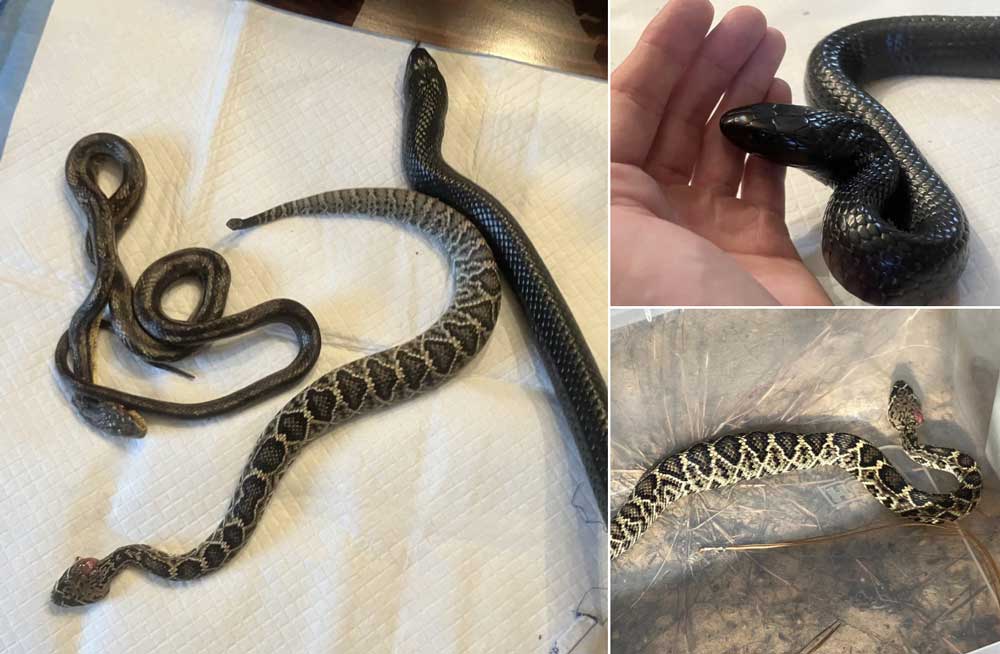At first glance, Moore believed that both snakes were dead, but upon closer inspection, Moore noticed that the rattlesnake's tail twitched
Georgia Department of Natural Resources wildlife technician Matt Moore was out tagging Eastern indigo snakes (Drymarchon couperi) when he came across a 4-foot Eastern indigo snake. The snake was somewhat unremarkable for its 4 ft length, though it was quite stout. Moore measured the reptile and then tagged it and placed it in his snake bag for weighing. Then things got, as Moore described it on the Georgia Wildlife blog, “A little weird.” When Moore opened the bag, he was surprised to find not one snake, but three: The now slimmed down Eastern indigo, a rat snake (Pantherophis sp.)and a juvenile eastern diamondback rattlesnake (Crotalus adamanteus). Moore said the bag was “… filled to the brim with snakes.”
At first glance, Moore believed that both snakes were dead, but upon closer inspection, Moore noticed that the rattlesnake’s tail twitched, which is not uncommon with recently deceased snakes. Moore then finished collecting the data on the Eastern Indigo, and then checked the table and noticed that the Eastern diamondback rattlesnake was moving about. Moore said that the indigo snake didn’t dispatch the rattlesnake first b=y crushing its skull and then swallowing the venomous snake whole. The rat snake was in a longer state of digestion, but the rattlesnake appeared to have been recently consumed.
Moore then released the now fully revived Eastern diamondback rattlesnake into a gopher tortoise burrow, but rather than climb down into the burrow, the rattlesnake decided to bask on a nearby patch of grass.
Moore took photos of the rattlesnake and released it. Three weeks later, someone observed a rattlesnake with the telltale wound on its head and the dorsal diamond pattern that matched the photographs he had taken of the snake.
Eastern Indigo Snake Information
The Eastern indigo snake is the longest native snake in the United States. It is known to sometimes reach more than 8 feet in length. The snake is a federally threatened species and certain restrictions are in place with regard to possessing them. A member of the Colubridae family, indigo snakes feed on a variety of animals. These include small mammals, amphibians, birds, lizards, baby turtles, and other snakes, including every species of venomous snake found in Florida.
The snake was historically found in southern Georgia, Alabama, eastern Mississippi and throughout much of Florida, but was largely extirpated from the ABRP due to habitat loss and fragmentation. The last sighting of an Eastern indigo in the ABRP occurred in 1982. The Apalachicola Bluffs and Ravines Preserve is the only area designated by the state for the introduction of the indigo snake. In 2022, a wild-hatched Eastern indigo snake was found in Alabama’s Conecuh National Forest. This marks the second time in 60 years that a wild specimen was observed in the wild.
Eastern Diamondback Rattlesnake Information
The Eastern diamondback rattlesnake is the biggest venomous snake in the Americas, with recorded lengths nearing eight feet and weights in excess of 35 pounds. The eastern diamondback has massive fangs that can approach a full inch long and can pump as much as 450 mg of venom (less than 150 mg can kill a human) in a single bite. They are known to inhabit pine forests, mountains, and dry marsh and coastal areas of Florida as well as the lower southeastern United States.


